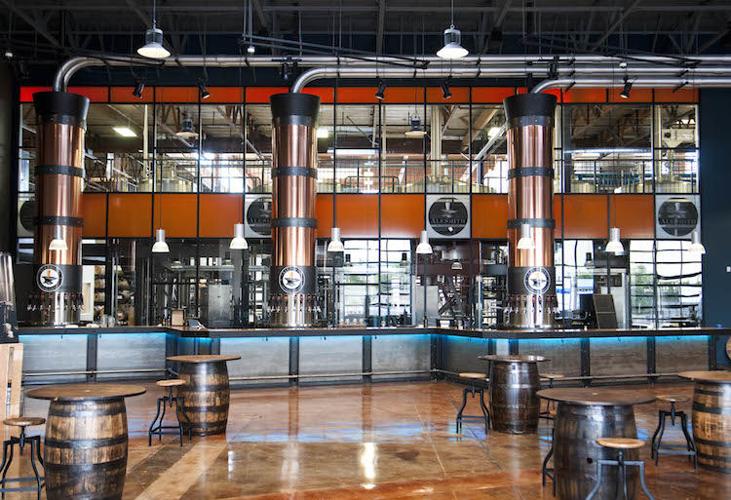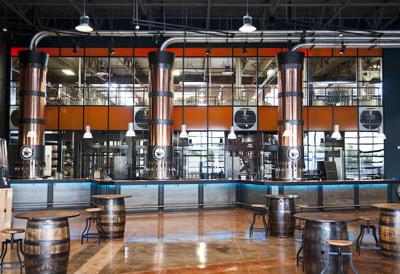With over one hundred craft breweries located in San Diego alone, Southern California has a unique handle on the art of crafting a good beer. Whether you love IPAs or coffee- inspired stouts, local craft beer is always right around the corner. Nowadays, beer isn’t the mass-produced drink frat boys chug in college to get plastered; a good beer is art. Or, as Peter Zien (CEO and founder of Miramar’s AleSmith Brewing Company) calls it, beer is liquid art. "It is very difficult to find two beers that are greatly alike, much like looking at paintings composed by different artists," he postulates. "We all leave our individual mark on our given work of art that we call our beer."
Beer is an art form like any other, and the tasting room is a gallery—don’t let the giant tanks fool you into thinking it’s a cold, industrial process. The brewer manipulates different variables to create a subjective experience for the senses. But like certain arts with complicated sets of tools, beer requires science. Ehren Schmidt of Vista’s Toolbox Brewing believes a good craft beer combines science with creativity. "Brewers do not create beer," Schmidt says. "Brewers create wort, or unfermented beer. Yeast is responsible for creating beer. Science allows me to create more interesting and unique beers, so I would say science complements the creative aspects of beer."
Toolbox only brews wild sour beer, leaving in the microbes many other brewers take out. Schmidt spends enormous amounts of time in the lab isolating microbes in the wild from items like flowers, bark, grass and even air. The end product is a distinct taste that many people might not recognize as beer—it creates a new flavor unique to Toolbox.
The ability to infuse unique and memorable flavors into their brews is part of what separates craft beer from a macrobrew. Macrobrews are the big names you see lining the shelves of the supermarket—Bud Light, Heineken, Guinness, etc. Traditionally, macrobreweries produce greater than six million barrels of beer each year, while most craft breweries produce less than two million barrels a year. Coors Light, for example, produced 18.2 million barrels in 2011. In contrast, AleSmith Brewing produced only 25,000 barrels in 2015.

Latitude 33 Brewery
Another technical aspect that separates craft beer from macrobrews is water content. Adam Vickers from Latitude 33 Brewing Company in Vista explains, "The difference between Budweiser and Bud Light is the amount of water they add in the beer... Macro beer is very simple." Craft beers focus more on flavor combinations, while macrobrews are focused on producing quantity.
While craft beers have more developed flavors, there is still merit to macro beers. Greg Peters from St. Archer Brewing Company believes in the power of beer—macro, micro, it doesn’t matter. "The majority of the beer I drink is local and ‘craft,’ whatever that means, but being passionate about beer means drinking what you like... Just because someone is drinking a macro beer, it doesn’t mean they don’t know beer. You would be surprised to see what some of the best brewers in the world have sitting in their fridge."
Inspiration can stem from anywhere—even macro beers— but there is something great about beer handmade by an artisan. Despite Peters’s insistence that a macro can be on par with a micro, he really puts the "craft" in craft beer. "There are definitely shortcuts to the process, but we don’t take them," he says. "The 300 pounds of coconut used in the [Imperial Coffee] Porter were hand-toasted in the convection oven at our friend’s restaurant in Oceanside. Instead of using generic cacao nibs and cinnamon, we went to extreme lengths to find a Mexican chocolate that was made using traditional techniques, and the results are noticeable."

Green Flash brewing
That attention to detail is the mark of a strong craft beer, but how does creating new brews begin? According to AleSmith’s brewer Ryan Crisp, it all boils down to thinking about new flavors. "Making a new beer starts with clearly identifying an intended flavor profile for the finished product," Crisp explains. "One of my favorite AleSmith beers is a Märzen-style lager we created a few years ago to celebrate the Oktoberfest holiday. It’s a clean, flavorful, malty lager that’s perfect for casual enjoyment. When we sat down to make the recipe, we started by trying to recreate the intense bready malt flavors of the classic examples we’d had." From there, AleSmith worked to update and produce a modern interpretation of the old ale.
After the initial inspiration for a new craft beer— whether it be a classic flavor or something wild—creating a beer is similar to writing an episode of a TV show. One person concocts an initial recipe, and if it goes through, the remainder of the team perfects it to make sure it’s suitable for mass sale. Many San Diego breweries today have a pilot system. This involves a tiny vessel that produces only a few gallons, perfect for testing inspirations that could soon be brewed in 600-gallon tanks and bottled in huge numbers.
Green Flash Brewing Company of Mira Mesa goes further than a simple pilot program. Brewmaster Erik Jensen explains, "The Genius Lab is a program where we basically allow any employee at Green Flash to approach a brewer and say ‘Hey, I have a great idea for a beer.’ The brewer fleshes out the idea and presents it to the Genius Lab, and if they agree it’s a good idea, it gets brewed." This program has allowed Green Flash to produce a wide array of new, delicious brews. For example, Cosmic Ristretto, a beer that originated in the Genius Lab, is now a Green Flash staple.
The Genius Lab highlights another theme in craft culture: togetherness. "Craft brew is not only an art, science and business, but a community too," Vickers of Latitude 33 explains. "It’s not a competition business. Everybody’s trying to help each other out, because we’re all trying to fight against the big guys." Community spirit is important to Latitude 33, who has used their massive tanks to brew a few batches for Belching Beaver and new brewery Thorn Street.
That, more than anything, is what separates a delicious craft beer from a macrobrew. Sure, a beer like Heineken may have been conceptualized around a table of hopeful brewers in the past, but now it’s produced and bottled by the millions. When you’re drinking a craft beer, you’re taking in passion, excruciating effort and a tight-knit community. With San Diego’s mecca of small breweries, venture into the world of craft beer and help the little guy—maybe every time. "Craft beer is about 15% of the market," Vickers points out. "That’s pretty negligible." With a close community and strong passion, it’s no wonder craft beer has become a classic part of San Diego.
For Related Articles Try:






(0) comments
We welcome your comments
Log In
Post a comment as Guest
Keep it Clean. Please avoid obscene, vulgar, lewd, racist or sexually-oriented language.
PLEASE TURN OFF YOUR CAPS LOCK.
Don't Threaten. Threats of harming another person will not be tolerated.
Be Truthful. Don't knowingly lie about anyone or anything.
Be Nice. No racism, sexism or any sort of -ism that is degrading to another person.
Be Proactive. Use the 'Report' link on each comment to let us know of abusive posts.
Share with Us. We'd love to hear eyewitness accounts, the history behind an article.